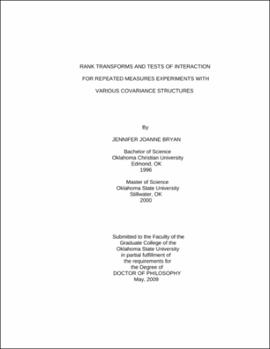| dc.contributor.advisor | Payton, Mark | |
| dc.contributor.author | Bryan, Jennifer Joanne | |
| dc.date.accessioned | 2013-11-26T08:28:10Z | |
| dc.date.available | 2013-11-26T08:28:10Z | |
| dc.date.issued | 2009-05 | |
| dc.identifier.uri | https://hdl.handle.net/11244/7018 | |
| dc.description.abstract | Scope and Method of Study: The covariance structure of a repeated measures design can be simple or very complicated. In analyzing repeated measures, rank transformations can be an alternative to the standard tests performed on the raw data. An alternative to utilizing the common rank transform when testing for interaction is the aligned rank procedure in which the estimate for the interaction effect is adjusted for the observed main effects. The question arises as to how the covariance structure may affect the aligned rank transform procedure when analyzing repeated measures, specifically the test of interaction. The objectives of this paper are 1) to find how the alignment for the aligned rank transform affects the repeated measures model, 2) to find the variance of the aligned observations, 3) to find the asymptotic distribution of the aligned rank transform test in a factorial setting, and 4) compare the standard F test, rank transform test, and two approaches to the aligned rank transform test (the naive approach or ART1 and the standard approach or ART2) in analyzing a repeated measures design with the use of Monte Carlo simulations. Five initial conditions will be considered: no main effects or interactions, only treatment main effects, only repeated measures main effects, both treatment and repeated measures main effects and only interactions. In addition to the initial conditions, five covariance structures will be simulated: variance components, compound symmetric and three types of first-order autoregressive. | |
| dc.description.abstract | Findings and Conclusions: The results of the simulation found that error rates for the ART1 performed closer to the desired 5 percent significance level than the ART2 for all but one case of the covariance structure and error distribution combinations. However, the ART2 was not a 0.05 test and was excluded from further discussion. When testing for interactions in a repeated measures design, the naive approach to the aligned rank transform should be used, especially in cases where the error distributions are not light tailed and the covariance structure is not known to be spherical. For heavy tailed error distributions, the standard F test should be used to test for interaction. | |
| dc.format | application/pdf | |
| dc.language | en_US | |
| dc.rights | Copyright is held by the author who has granted the Oklahoma State University Library the non-exclusive right to share this material in its institutional repository. Contact Digital Library Services at lib-dls@okstate.edu or 405-744-9161 for the permission policy on the use, reproduction or distribution of this material. | |
| dc.title | Rank transforms and tests of interaction for repeated measures experiments with various covariance structures | |
| dc.contributor.committeeMember | Claypool, P. Larry | |
| dc.contributor.committeeMember | McCann, Melinda | |
| dc.contributor.committeeMember | Mantini, Lisa | |
| osu.filename | Bryan_okstate_0664D_10220.pdf | |
| osu.accesstype | Open Access | |
| dc.type.genre | Dissertation | |
| dc.type.material | Text | |
| dc.subject.keywords | covariance structure | |
| dc.subject.keywords | rank transforms | |
| dc.subject.keywords | repeated measures | |
| thesis.degree.discipline | Statistics | |
| thesis.degree.grantor | Oklahoma State University | |
